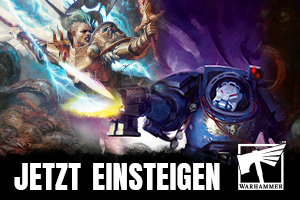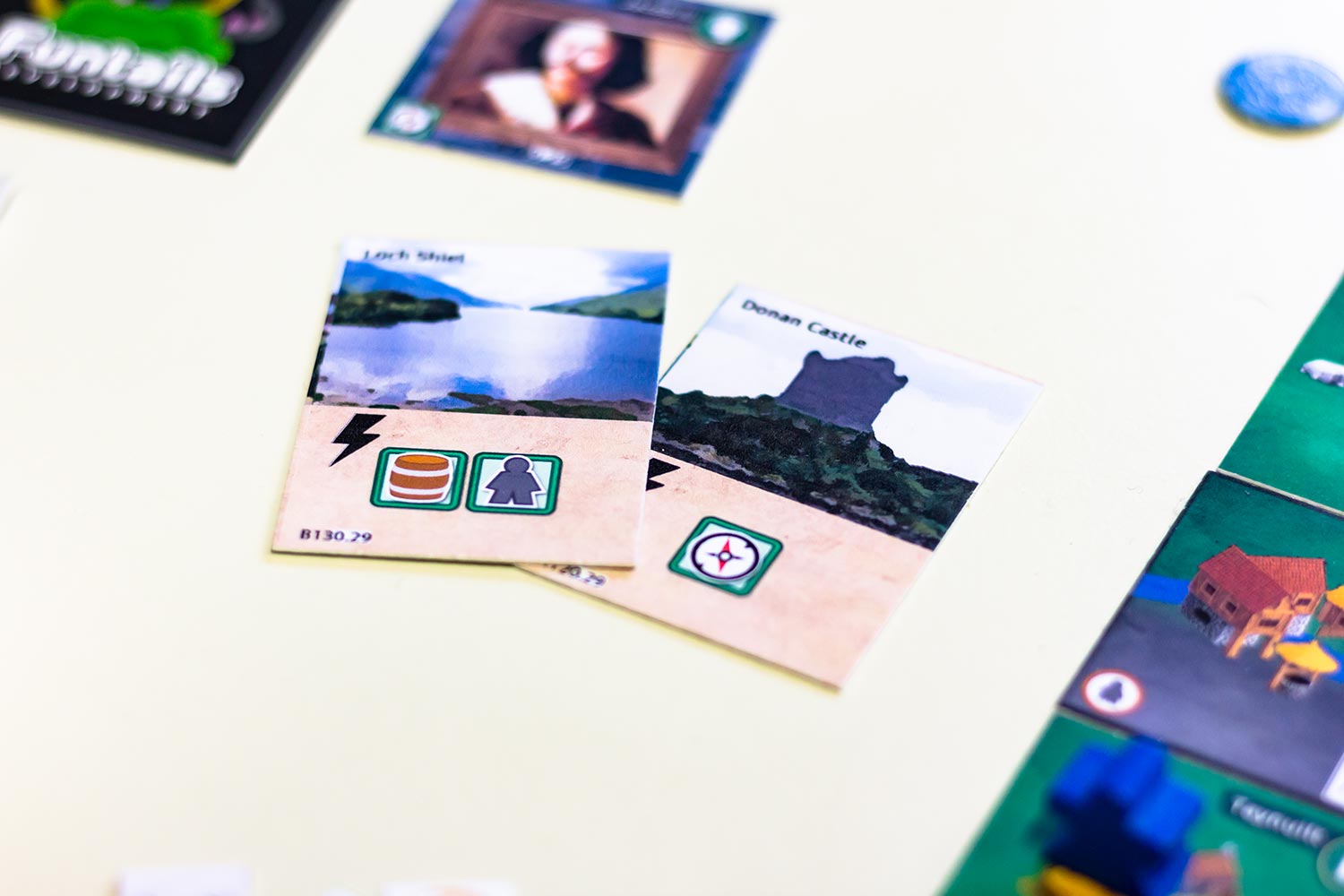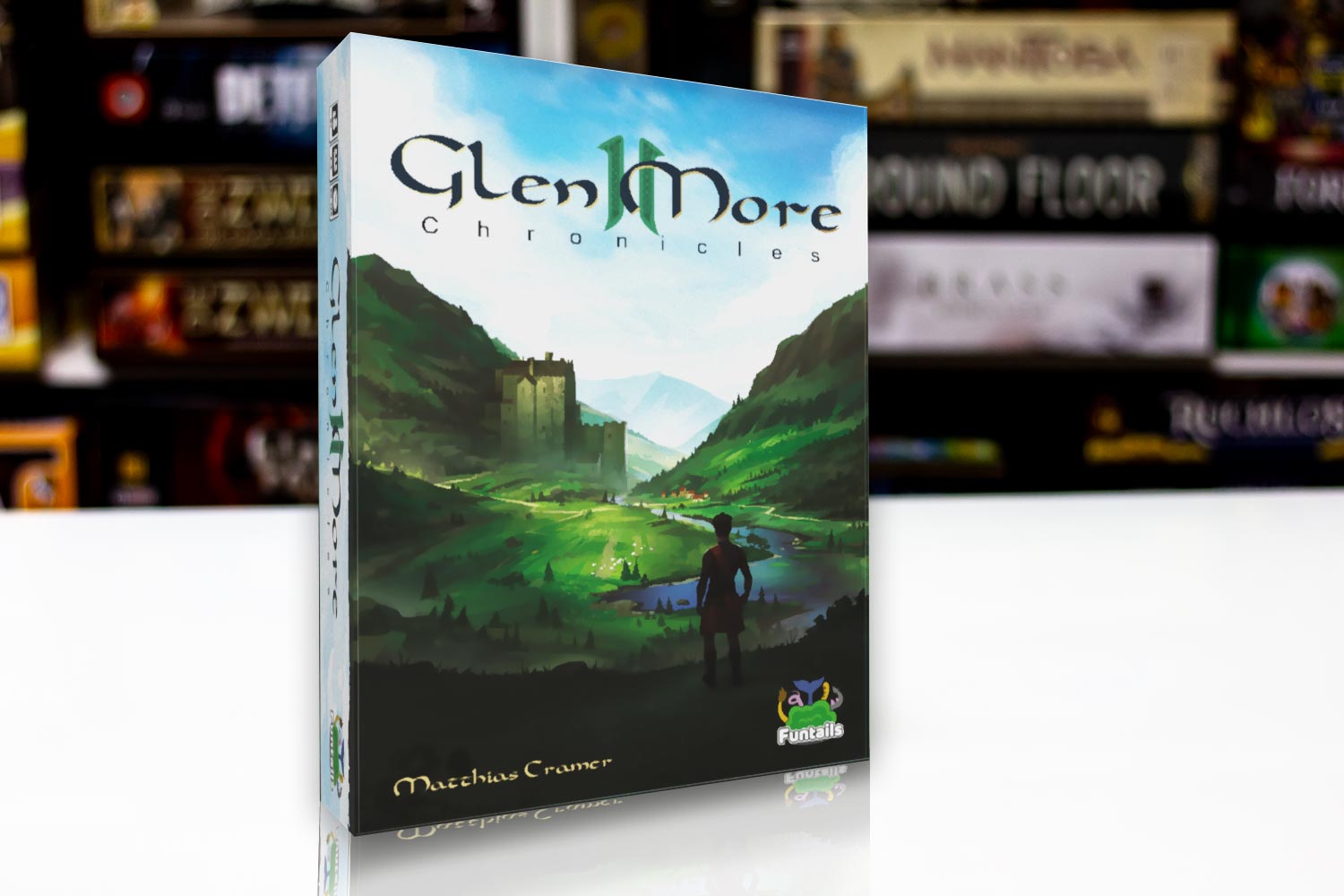
TEST // Glen More II: Chronicles (Prototyp)
Im März 2016 haben wir erstmals den Nachfolger des beliebten Glen More Spiels in auf den Ratinger Spieletagen gespielt. Fast drei Jahre danach konnten wir die spielerisch nahezu finale Version von "Glen More II" spielen, die schon bald auf Kickstarter starten wird. Lesen Sie hier, warum das Spiel einen Blick wert sein wird.
Das ist Glen More II: Chronicles
„Glen More“ ist 2010 bei Alea erschienen. Das Spiel fand damals viele Freunde und war ein unglaublicher Verkaufserfolg. Nun strebt der neu gegründete Verlag Funtails an, den zweiten, stark überarbeiteten Teil zu veröffentlichen. Die Finanzierung soll über Kickstarter realisiert werden. Der Creative Direktor Andreas Geiermann sagte uns gegenüber, dass sie das beste Drittel des Spiels erhalten wollten, ein Drittel sollte besser gemacht werden und ein Drittel gänzlich neu erschaffen sein.
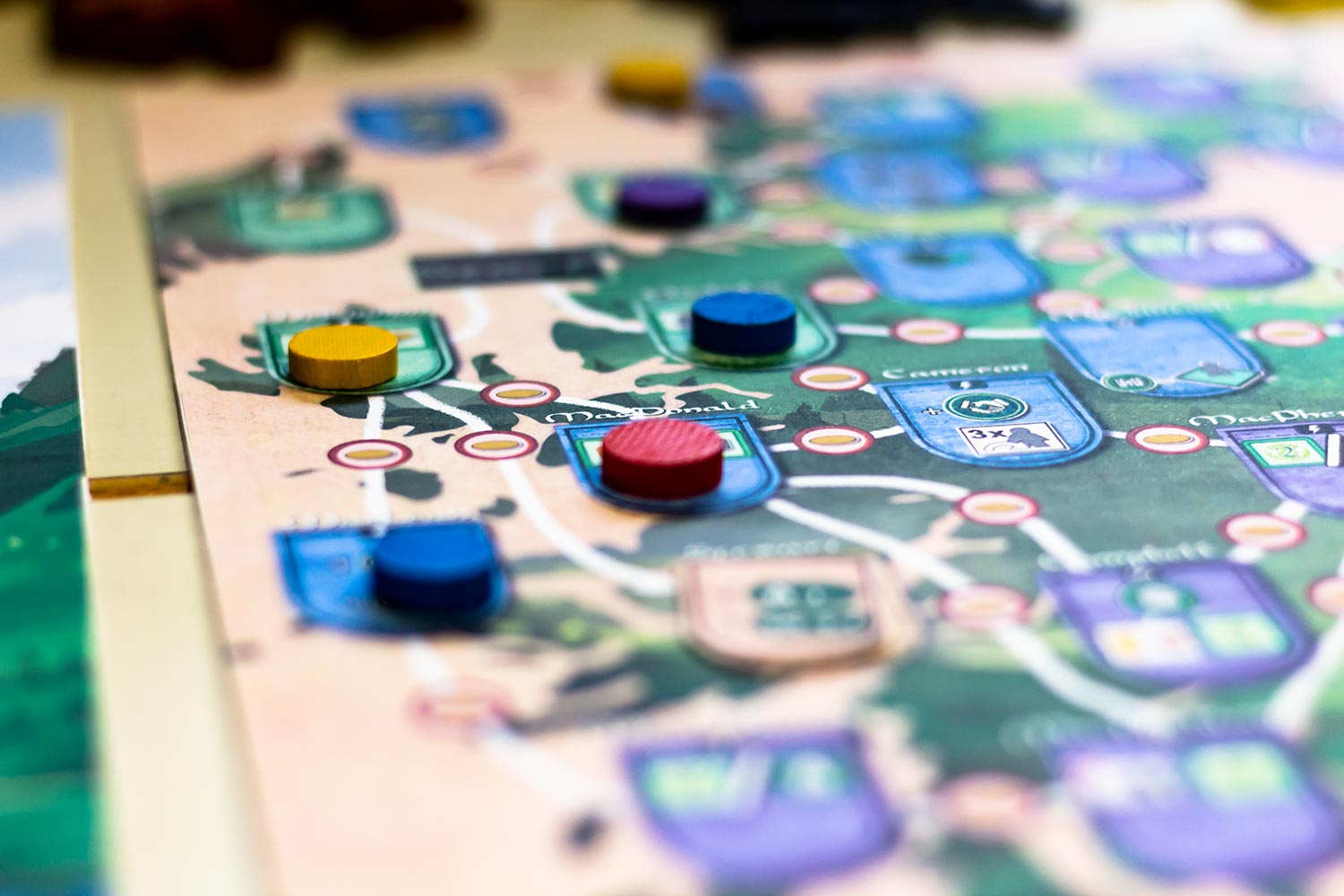
Wir testeten das Spiel mit einer Partie auf einem Spieletreff in Mönchengladbach. Dabei spielten wir eine der acht Chronicles, die im Spiel enthalten sein werden. Michael und Daniel von Brettspiel-News.de und zwei befreundete Spieler spielten das Spiel und probierten es in Ruhe aus. Gespielt wurde ein Prototyp, der optisch noch absolut nicht final war. Die Regeln waren jedoch schon fertig und alles funktionierte reibungslos.
Exkurs zu Glen More
„Glen More“ ist ein Rondell Spiel, bei dem Plättchen in einer Art Kreis ausliegen und die Spieler entscheiden bei jedem Zug, wie weit sie vorwärts ziehen um sich ein Plättchen zu nehmen. Sie sind dann erst wieder an der Reihe, wenn die anderen Spieler vorbeigezogen sind.
Wer sich auf ein Plättchen setzt, muss dieses bezahlen können. Das Plättchen wird in das eigene Reich eingebaut und alle angrenzenden Plättchen werden einmal aktiviert. Dabei gibt es Gebäude, die Rohstoffe (Korn, Holz, Kühe, Schafe und Stein) erzeugen. Es gibt weiterverarbeitende Gebäude, wie Schlachthöfe (generieren Siegpunkte) oder Brennereien, die schottischen Whisky produzieren und viele mehr.
Zudem können einzigartige historische Gebäude errichtet werden, die dem Besitzer Vorteile bringen und bei der Siegpunkteverteilung relevant sind – das Plättchen muss ebenfalls in das eigene Clangebiet eingebaut werden.
Es werden Clanmitglieder angeworben und „Chieftains“ ernannt. „Chieftains“ sind die zweite Art um in den Zwischenwertungen Punkte zu sammeln.
Die dritte Art sind die Whisky-Fässer, die zu diesem Zweck herhalten müssen.
Zwischenwertung
Im alten Glen More gab es drei Stapel, die jeweils auf das Rondel nach und nach leer gespielt wurden. War ein Stapel erschöpft, wurde eine Zwischenwertung ausgelöst. Dabei erhielten die Spieler Siegpunkte in der Höhe der Differenz zwischen dem der am wenigsten hat, zu dem eigenen Anzahl. Wenn ein Spieler 5 Whisky-Fässer hat und ein anderer 0, dann ist die Differenz 5. Auf einer Tabelle wird dann nachgeschaut, wie viele Punkte das einbringt. Es werden wie schon Beschrieben Whisky-Fässer, „Chieftains“ und Orte zahlenmäßig verglichen, dann geht das Spiel weiter.
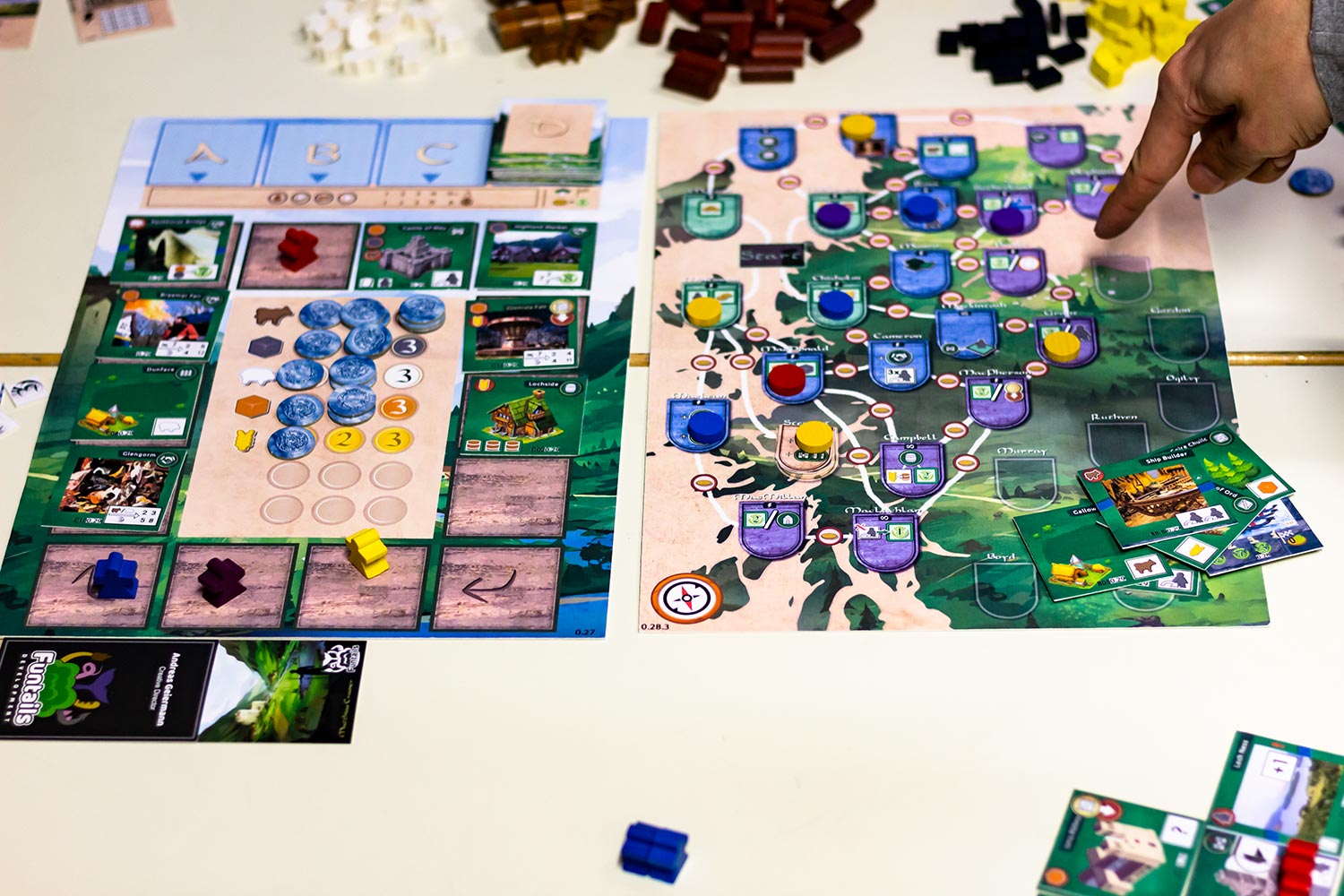
Endwertung
Sobald die dritte Wertung stattgefunden hat, endet das Spiel und die Schlussabrechnung findet statt. Wichtig bei der Endwertung ist die Anzahl der Plättchen.
Das ist neu in Glen More II
Es hat sich einiges getan. Neben den Grundfunktionen wie zuvor beschrieben wandern nun Charaktere in das Spiel. Diese bieten Funktionen auf einen externen Spielplan. Dort wird nach und nach immer mehr freigeschaltet. Jeder Bonus ist nur einmal möglich. Das spornt an und ergibt mehr Möglichkeiten als nur seine Plättchen passend zu legen.
Zudem hat die gespielte Chronicle Spaß bereitet und sich sinnvoll in das Spiel eingefügt. Zum einen bleibt das Gefühl, Glen More auf dem Tisch zu haben, zum anderen hat sich richtig viel getan. Die vielen Jahre der Entwicklung zahlen sich hier offensichtlich positiv aus. Wir waren mit zwei Spielern, die das erste Glen More kennen am Tisch und zwei, die es noch nicht gespielt hatten. Allen hat es Spaß gemacht. Optisch war es noch ausbaufähig, was bei einem Prototypen kein Wunder zu sein scheint. Erste Bilder des finalen Material waren hingegen mehr als vielversprechend. Der Verlag will hier nicht kleckern, sondern klotzen!
Wer „Glen More“ gerne gespielt hat oder gerne spielt - und davon soll es einige geben – der kann sich die neue Version unbedingt anschauen. Die Ideen, die noch für die anderen Chronicles bieten hörten sich sehr gut an und somit erscheint das Spiel viel Abwechslung zu bieten. Aus der Erfahrung heraus, dass sich die erste Chronicle sehr gut in das Spiel eingepasst hat und dem großen Aufwand, den der Autor seit Jahren betreibt wird es am Ende ein gutes bis sehr gutes Spiel geben.
Besonders gut hat mir der Plan gefallen, der neben das Spielfeld kommt und auf dem sich zusätzliche Boni erhalten lassen. Dies bietet schon allein neben den vielen modularen Erweiterungen eine gute Alternative um Punkte zu sammeln, oder die eigene Spielweise stärker zu untermauern. Es gibt auch viel Potential auszuprobieren, welche der Boni in welcher Situation am sinnvollsten sind.
Außerdem finde ich nach wie vor den „großen Gleichmacher“ eine kleine aber feine Lösung. Durch das Punkte abziehen am Spielende für zu groß geratene Ländereien wird das grenzenlose Sammeln von Plättchen die schlechteste Option. Es lohnt sich Gedanken zu machen welches Plättchen wirklich gebraucht wird und es muss immer mit den Mitspielern verglichen werden, um nicht zu übertreiben.
Durch die neuen und alten Aspekte des Spiels, hat der Autor etwas mehr Interaktion bzw. Berührungspunkte mit den Mitspielern in das Spiel gebracht, was ihm merklich guttut.

Da ich bislang von „Glen More“ zwar gehört, es selbst aber noch nicht gespielt hatte, ging ich recht unbelastet an das Spiel des Prototypens heran. In den ersten 1-2 Runden musste ich mich zwar erst mal ein wenig in die Mechanik einfinden. Wie etwa was wann aktiviert wird, worauf zu achten ist beim Anlegen der Plättchen oder auf welche Fähigkeiten, welchen schottischen Edelmannes ich meine Marker setzen sollte, auf der Tafel mit den Belohnungen. Danach war ich schnell im Spiel und konnte mich zeitnah mit möglichen Strategien vertraut machen, die mir hoffentlich ganz viele Siegpunkte bringen würden.
Auf Grund der Lage der Plättchen und der vermuteten Strategien meiner Mitspieler verlegte ich mich auf die Whiskey-Produktion. Getrunken wird immer, ein Getreidefeld hatte ich in meiner Anfangsphase ohne Plan bereits geholt und eine Destillerie lag in Schrittweite aus. Als zweites Standbein wählte ich später noch die Schlachterei, da ich – wie Andreas von Funtails sie liebevoll nannte – einige McMuhs und McMähs angesammelt hatte und diese gerne in Siegpunkte umwandeln wollte. Das hört sich zunächst zwar nicht sonderlich tierlieb an, aber da es sich bei dem Schlachtgut um Holzmeeples handelte, war zum Glück genügend Distanz zur Realität gegeben. Ein wenig Energie setzte ich dann noch auf das Bootsrennen, das während des Spiels als Chronik startete und einmal quer über alle schottischen Reiche führte. Nach rund 2 Stunden Spielzeit, die wie im Flug vergingen, war ich zufrieden mit meiner Leistung im schottischen Hochland.
„Glen More II“ war durchaus anzumerken, dass der Prototyp bereits einiges an Entwicklungszeit auf den Highlands hat, vor allem das Balancing erschien mir schon recht gut gelungen. Zu keinem Moment gab es das Gefühl, dass eine Fähigkeit zu mächtig ist oder eine Strategie in eine Sackgasse führt. Die Idee mit den Chronicles ist gut und durch die spätere Möglichkeit aus 8 verschiedenen Varianten zu wählen, ergibt sich ein recht hoher Wiederspielwert. Die 4er-Gruppe, in der wir gespielt haben, erschien mir von der Spielerzahl perfekt. Mit weniger dürfte einiges an Wettbewerb um die Plättchen verloren gehen; als 2-Spielerspiel stelle ich mir den Wettkampf um die Siegpunkte etwas dröge vor, lasse mich später hier aber auch gerne eines Besseren belehren.
Was das Spielen des Prototypens von „Glen More II“ anbetrifft, kann ich für mich feststellen, dass dieser im Wettkampf mit 3 weiteren Lairds kurzweilig für beste Unterhaltung bei mir gesorgt hat. Das Spiel bot einige Entscheidungsmöglichkeiten, es belohnte auch kurzfristige Strategien und ließ mich nie mit dem Gefühl zurück, hoffnungslos unterlegen zu sein, nur weil ich in meiner anfänglichen Orientierungslosigkeit aufs falsche Schaf gesetzt hatte. Die ersten Bilder, die ich vom finalen Artwork des Spiels gesehen habe, konnten mich zusätzlich überzeugen. Wer strategische Spiele für ein Spielerquartett sucht, sollte sich mit „Glen More II Chronicles“ ernsthaft auseinandersetzen.
Bilder zum Spiel
Review // Glen More II: Chronicles (prototype)
In March 2016 we played the successor of the popular Glen More game at the Ratinger Spieletage for the first time. Almost three years later we were able to play the almost final version of "Glen More II", which will soon start on Kickstarter. Read here why the game will be worth a look.
This is Glen More II: Chronicles
"Glen More" was released by Alea in 2010. The game found many friends and was an incredible sales success. Now, the newly founded publishing house Funtails is striving to publish the second, greatly revised, part. The financing should be realized via Kickstarter. Creative Director Andreas Geiermann told us that they wanted to keep the best third of the game, a third should be improved, and the final third should be completely recreated.

We tested the game with a game convention in Mönchengladbach. There, we played one of the eight Chronicles that will be included in the game. Michael and Daniel from Brettspiel-News.de and two friends played the game and tried it out in peace. A prototype was played, which was optically still far from final. However, the rules were already in place and everything went smoothly.
Excursion to Glen More
"Glen More" is a roundel game in which tiles are laid out in a kind of circle and the players decide how far they want to go to take a tile each turn. It's your turn again once the other players have passed by.
Anyone who places themselves on a tile must be able to pay for it. The tile is built into your own realm and all adjacent tiles are activated once. In this realm, there are buildings that produce raw materials (grain, wood, cows, sheep and stone). Further, you might find processing buildings such as slaughterhouses (generating victory points) or distilleries that produce Scottish whisky and many more.
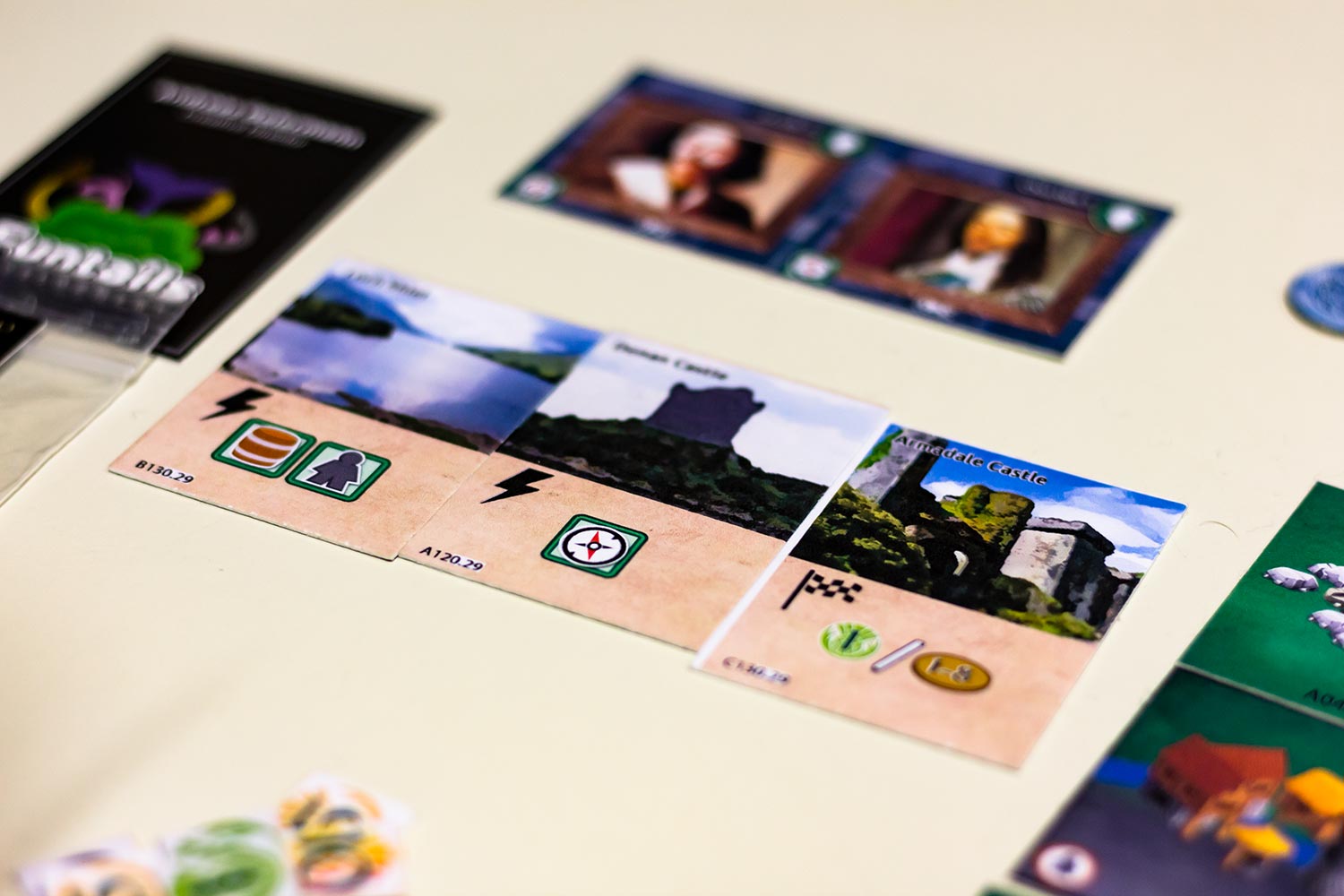
In addition, unique historical buildings can be erected, which bring advantages to the owner and are relevant for the distribution of victory points - the tile must also be built into the own clan area.
Clan members are recruited and "Chieftains" appointed. "Chieftains" are the second way to earn points in the intermediate scoring.
The third type are the whisky barrels, which are must serve this purpose.
Intermediate scoring
In the old Glen More there were three stacks, which were played on the rondel bit by bit empty. Once a stack was exhausted, an interim evaluation was triggered. The players received victory points equal to the difference between the player with the least points and their own number. If one player has 5 barrels of whisky and another has 0, then the difference is 5. A table is then used to see how many points this earns. As previously described, whisky barrels, "Chieftains" and places are compared numerically, then the game continues.

Final score
As soon as the third evaluation is completed, the game ends and the final settlement takes place. The number of plates is important for the final score.
This is new in Glen More II
Much has changed. In addition to the basic functions describe above, characters now move into the game. These offer functions on an external game board. There, more and more will be progressively unlocked. Each bonus is only possible once, though. This encourages and gives you more possibilities than just laying your tiles in a fitting way.
In addition, the Chronicle was fun to play and was a useful part of the game. On the one hand, the feeling of having Glen More on the table remains, on the other hand, plenty of changes have happened. The many years of development are obviously paying off here. We were at the table with two players who knew the first Glen More and two who hadn't played it yet. Everyone enjoyed it. Visually it was still expandable, which is expected with a prototype. The first pictures of the final material, however, were more than promising. The publisher really wants to raise the bar here!

If you enjoyed "Glen More" - and there should be some of you - you should definitely keep an eye out for the new version. The ideas for the other Chronicles sounded very good and so the game seems to offer a lot of variety. Based on the experience that the first Chronicle fits very well into the game and the great effort the author has put in for years, it will become a good or very good game in the end.
I particularly liked the plan, which is placed adjacent to the game board and on which additional bonuses can be gained. This alone offers a good alternative to the many modular expansions to collect points, or to underpin your own style of play more strongly. There is also a lot of potential to try out which of the bonuses make the most sense in which situation.
In addition, I still believe the "big equalizer” to be a neat solution. By deducting points at the end of the game for oversized estates, the incessant collection of tiles becomes the worst option. It is worthwhile to think about which tile is really needed and it must always be compared with the other players in order not to accumulate excessive amounts.
Through the new and old aspects of the game, the author has brought some more interaction and points of contact with the other players into the game, which clearly improves the experience.

Since I had heard of "Glen More" but had not yet played it myself, I approached the prototype game with few preconceptions. In the first 1-2 rounds, I had to learn the mechanics. How, for example, what is activated when, what to watch out for when placing the tiles or which abilities, which Scottish nobleman I should place my markers on, on the reward board. After that, I was quickly in the game and was able to familiarize myself with possible strategies that would hopefully bring me plenty of victory points.
Due to the position of the plates and the presumed strategies of my fellow players, I decided to focus on my whiskey production. Drinking is always popular, I had already secured a grain field in my initial phase without a plan, and a distillery was in walking distance. Later, I chose the butcher's shop as my second mainstay, as I - as Andreas of Funtails lovingly called it - had accumulated a few McMoos and McBaahs and wanted to convert them into victory points. That doesn't sound very animal-loving at first, but since the slaughter goods were wooden meeples, there was luckily enough distance to reality. I then put a some energy into the boat race, which started during the game as a chronicle and led us across all Scottish empires. After about 2 hours playing time, which passed in the blink of an eye, I was satisfied with my performance in the Scottish Highlands.
"Glen More II" was quite clearly a prototype with significant development time on the Highlands, especially the balancing seemed to me to be quite well done. At no moment was there the feeling that an ability was too powerful or that a strategy would lead to a dead end. The idea with the Chronicles is good and a high replay value results from the possibility of choosing among 8 different variants in future. The group of four in which we played seemed perfect to me in terms of the number of players. With less competition for the tokens, some of it might be lost; as a 2-player game, I imagine the competition for victory points to be a bit dull, but I’m happy to be proven wrong.
As far as playing the prototype of "Glen More II" is concerned, I can say for myself that it provided me with the best entertainment in the competition with 3 other Lairds. The game offered choices, it rewarded short-term strategies and never left me with the feeling of being hopelessly inferior just because I had bet on the wrong sheep in my initial confusion. The first pictures I saw of the final artwork of the game convinced me even more. If you are looking for strategic games for a quartet of players, you should take a serious look at "Glen More II Chronicles".
Tags: 2-4 Spieler, 90-120 Minuten, Crowdfunding, Städtebau, Kickstarter, Wirtschaft, Landwirtschaft, Territorien Ausbau, Schottland, Würfel, Sets erstellen, Teile Platzieren


